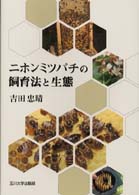- ホーム
- > 洋書
- > 英文書
- > History / World
Full Description
Landscapes have been fundamental
to the human experience world-wide and throughout time, yet how did we as human
beings evolve or co-evolve with our landscapes?
By answering this question, we can understand our place in the complex,
ever-changing world that we inhabit.
This
book guides readers on a journey through the concurrent processes of change in
an integrated natural-cultural history of a landscape. While outlining the general principles for
global application, a richly illustrated case is offered through the Mariana
Islands in the northwest tropical Pacific and furthermore situated in a larger
Asia-Pacific context for a full comprehension of landscape evolution at
variable scales. The author examines what
happened during the first time when human beings encountered the world's Remote
Oceanic environment in the Mariana Islands about 3500 years ago, followed by a
continuous sequence of changing sea level, climate, water resources, forest
composition, human population growth, and social dynamics. This book provides a high-resolution and
long-term view of the complexities of landscape evolution that affect all of us
today.
Contents
Part one: Parameters of
study
Chapter 1: Landscape
evolution as natural-cultural history
Evolution of an inhabited
landscape
The Marianas landscape as a
model system
Structure and content of
this book
References
Chapter 2: Global
applicability of landscape evolution
Coastal China
California
Hawaiian Islands
Mariana Islands
References
Chapter 3: Environmental
setting and dynamics
Geological structure
Sea-level history
Coastal geomorphology
Slope erosion-deposition
patterns
Soil formation
Plant and animal communities
Climate and weather
Water sources
References
Chapter 4: Marianas
archaeology in local and regional perspectives
Marianas settlement in
Asia-Pacific context
Foundations of Chamorro
heritage
References
Chapter 5: Coordinating perspectives
of the past
Historical perspectives
Linguistics
Human biology and genetics
Faunal records
Botanical records
References
Chapter 6: Range of
archaeological material culture
Artefacts
Midden
Structural features
Rock art
Caves
Landscapes
References
Part Two: Chronological
sequence
Chapter 7: Building an
archaeological chronology
Use of radiocarbon dating
Marianas chronological
outline
References
Chapter 8: 1500-1100 B.C.,
initial settlement
Site inventory and dating
Landforms
Resource zones
Material culture
Regional context
References
Chapter 9: 1100-700 B.C.,
changing coastlines
Site inventory and dating
Landforms
Resource zones
Material culture
Regional context
References
Chapter 10: 700 B.C.-A.D. 1,
broadened horizons
Site inventory and dating
Landforms
Resource zones
Material culture
Regional context
References
Chapter 11: A.D. 1-500,
temporary stability
Site inventory and dating
Landforms
Resource zones
Material culture
Regional context
References
Chapter 12: A.D. 500-1000,
sustained use of coastal and inland zones
Site inventory and dating
Landforms
Resource zones
Material culture
Regional context
References
Chapter 13: A.D. 1000-1700,
a sea of islands and monuments
Site inventory and dating
Landforms
Resource zones
Material culture
Regional context
References
Chapter 14: A.D.
1700-Present, living with colonialism and globalisation
Site inventory and dating
Landforms
Resource zones
Material culture
Regional context
References
Part Three: Pursuing
research questions
Chapter 15: First inhabiting
of a landscape
Human migration into a new
landscape
Initial inhabiting of a
landscape
Origins of landscape
evolution
References
Chapter 16: Long-term
human-environment relations
Geology and landforms
Climate
Sea level and coastal
ecology
Water sources
Plant and animal populations
Patterns of residence and
resource use
Material culture
Continuity and change
References
Chapter 17: Future
directions








